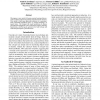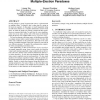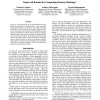17 search results - page 2 / 4 » Good Rationalizations of Voting Rules |
COGSCI
2008
13 years 4 months ago
2008
We propose a new model of human concept learning that provides a rational analysis for learning of feature-based concepts. This model is built upon Bayesian inference for a gramma...
SIGECOM
2011
ACM
12 years 7 months ago
2011
ACM
In many settings, a group of agents must come to a joint decision on multiple issues. In practice, this is often done by voting on the issues in sequence. In this paper, we model ...
ISIM
2007
13 years 6 months ago
2007
Software architecture, and its behavior can be expressed as UML models. Models of complex systems can be also complex and hard to read – they may consists of hundreds of artifact...
AAAI
2006
13 years 6 months ago
2006
Voting (or rank aggregation) is a general method for aggregating the preferences of multiple agents. One voting rule of particular interest is the Kemeny rule, which minimizes the...
ICPR
2008
IEEE
13 years 11 months ago
2008
IEEE
If there are more clusters than the ideal, each intrinsic cluster will be split into several subsets. Theoretically, this split can be arbitrary and neighboring data points have a ...



